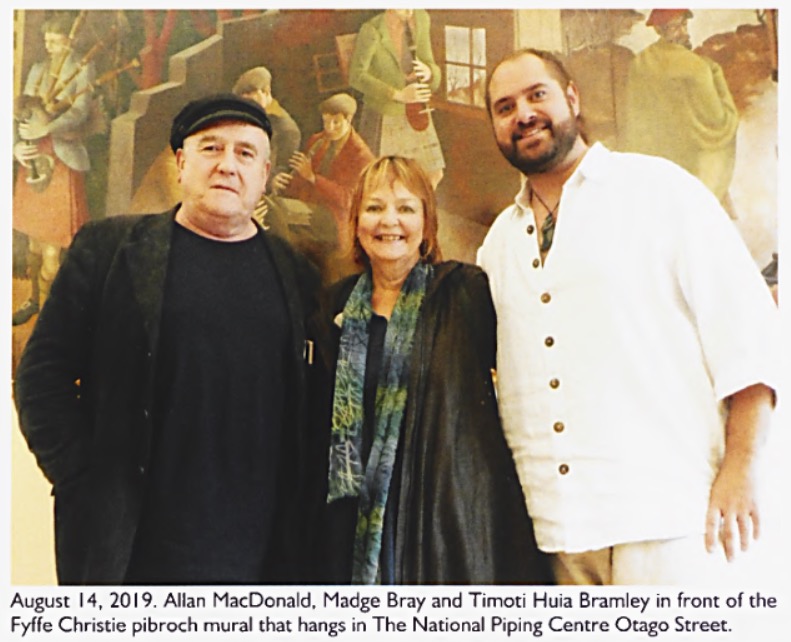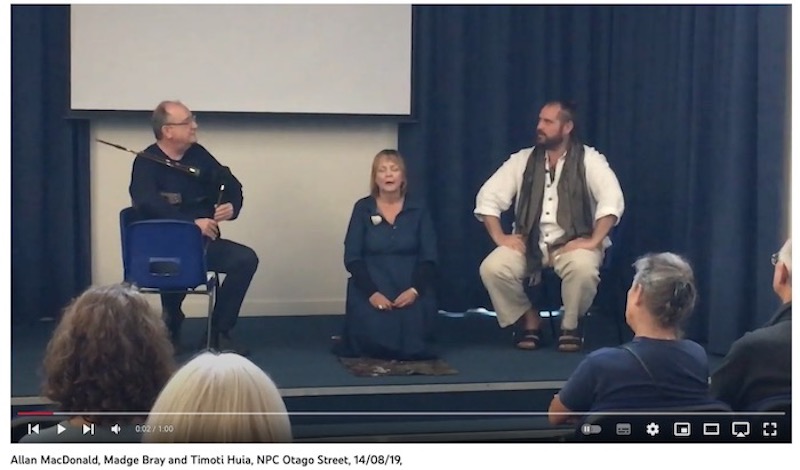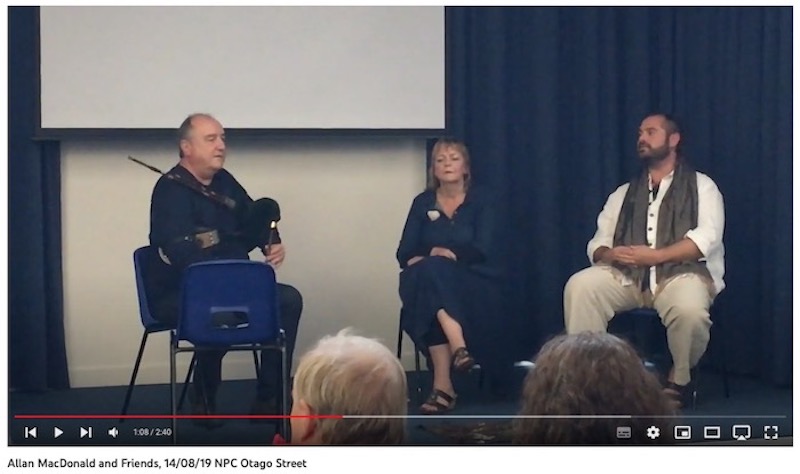第56話(2023/2)
蘇る "keening" 文化 パイプのかおり第50話で Allan MacDonald の "Dustirum"
を詳細に紹介した際、アルバム9番目 の曲 "A Lament"
の解説の中で、キーニング
(keening)に関する大変興味深い話が書いてありました。宗教会議に
よって禁止され、今では廃れてしまったという「キーニング」に興味が湧きましたが、ただただ想像するより外はありません。
ところが、なんと 2019年の Piping Live! に於ける Piobaireachd of the Day の一つのリサイタルに於いて、Allan MacDonald によって "Park Piobaireachd No.2" をキーニング付きで再現したパフォーマンスが演じられたとの事。更には、"Lament for Mary MacLeod" のシンギングバージョンも…。
古(いにしえ)のピーブロックが元々どの様に演奏されて いたのか? このイベントを報じた "Piping Times" と "Piping Today" の記事を通じて、想いを馳せてみましょう。
ところが、なんと 2019年の Piping Live! に於ける Piobaireachd of the Day の一つのリサイタルに於いて、Allan MacDonald によって "Park Piobaireachd No.2" をキーニング付きで再現したパフォーマンスが演じられたとの事。更には、"Lament for Mary MacLeod" のシンギングバージョンも…。
古(いにしえ)のピーブロックが元々どの様に演奏されて いたのか? このイベントを報じた "Piping Times" と "Piping Today" の記事を通じて、想いを馳せてみましょう。
| 2019 Piping Live! -
Piobaireachd of the Day: Allan MacDonald by Stuart Letford "Piping Times" Vol.71/12-2019/9 |
|
| 原 文 |
日本語訳 |
|---|---|
| This was the third
of four Piobaireachd of the Day (PoD) recitals
at this year’s Piping Live! festival and it
was anticipated keenly. Allan welcomed us and before strapping on his smallpipes passed around copies of the Park Piobaireachd score taken from the Kilberry book. It was the No. 2 setting. "I appreciate some of you won’t be able to read music," said Allan. "That’s no bad thing." He then passed around Colin Campbell’s piping notation of the tune (the Campbell Canntaireachd). The Battle of Park took place near Strathpeffer around 1490, prior to the collapse of the Lordship of the Isles, after which, Allan told us, “all hell broke loose in the highlands and islands for a very long time.” Allan sees the tune as a lament but not in the eulogistic bardic style. Rather, it is a supreme example, alongside MacIntosh’s Lament, Lament for the Laird of Anapool, Lament for the Children and others of that ilk, of keening, i.e. songs associated with the ceremony of death and the resolution of grief. The Synod of Argyll banned keening in 1642 but it remained in pockets until the early 20th century and indeed later in remote parts of Ireland. Why was it banned? Well, simply because the extravagant outpourings of grief were deemed inappropriate and un-Christian and contained no reference to an afterlife in the ritual. In the modern era, it is difficult to picture such a ritual but at this afternoon’s PoD we witnessed a powerful and highly emotional interpretation. This was the literal meaning of the Gaelic word ‘cumha’, the fervour inherent in lamentation. |
これは、今年の Piping
Live!festival の4つの Piobaireachd of the
Day(PoD)リサイタルのうちの3番目で、とても期待されていたものだった。 Allan は私たちを歓迎し、 スモールパイプを手にする前に、Kilberry Book 版 "Park Piobaireachd" の楽譜を手渡した。それは No.2 セッティングであった。「楽譜を読めない人がいることは承知している。それは悪いことではない。」 と Allan は言った。次に、Collin Campbell によるパイピングの記譜(Campbell Canntaireachd)が渡された。 The Battle of Park は、Lordship of the Isles が崩壊する前の1490年頃に Strathpeffer の近郊で行われた戦いで、その後「ハイランド地方と島嶼部では長い間、大混乱が続いた。」と Allan は語った。 Allan は、この曲をラメン トと して捉えているが、賛美的な吟遊詩人風としてではない。むしろ、"MacIntosh’s Lament"、"Lament for the Laird of Anapool"、"Lament for the Children" などの類の、 キーニング、つまり死の儀式と悲しみの解消に関する歌の最高の例であるという。 1642年、アーガイルの宗教会議によってキーニングは禁止されたが、20世紀初頭まで、そして その 後もアイルランドの遠隔地では、キーニングは残っていた。なぜ禁止されたのだろうか。それは、単に、悲 しみを贅沢に吐き出すことが不適切でキリスト教的でないと判断され、儀式に死後の世界への言及が含 まれ ていなかったからであろう。 現代では、このような儀式をイメージすることは難しいが、この日午後の PoD では、力強く、非常にエモーショナルな解釈を目の当たりにすることができた。これはゲール語の "cumha" の文字通りの意味であり、悲しみの慟哭に内在する熱気だった。 |
 |
|
| Madge Bray and Timoti Huia
Bramley joined Allan on the stage. Madge is a singer who was born in Aberdeenshire and spent much of her childhood on Scotland’s west coast. She lived for years in Georgia ー the Caucasus one not the state in eastern USA ー where she was exposed to its tradition of songs of death and suffering. Timoti is a New Zealander of MacKay descent who discovered ceol mor recently and realised there was a similarity between it and his native Maori keening tradition. Firstly, Allan played the ground straight from the Kilberry score, in what he’d described as the “modern, competition style.” Then he, Madge and Timoti ‘sang’ the song to Allan’s smallpipes (in C) accompaniment. Most of the audience joined in, too. What we heard was simply astonishing and difficult to describe in words. The sheer power of the chanting ー the keening ー was actually discomforting at times. |
Madge
Bray と Timoti
Huia Bramley が Allan
と一緒にステージに登場した。 Madge はアバディーンシャーで生まれ、幼 少期のほとんどをスコットランド西海岸で過ごしたシンガーである。彼女は何年かジョージア(アメリカ東 部の州ではなくコーカサスの方)に住み、そこで死や苦しみを歌った伝統的な歌に触れた。 Timoti は MacKay 一族の血筋を引くニュージーランド人で、最近 Ceol Mor と出会い、Ceol Mor が彼のもう一つの血筋であるマオリ族のキーンニングの伝統と類似していることに気付いた。 まず、Allan が Kilberry の楽譜をそのままに、彼が言うところの「現代的なコンペティションで演奏されるスタイル」でグラウンドを演奏した。そして、Allan のスモールパイプ(C調)の伴奏に合わせて、彼と Madge、 Timoti が曲を《歌い》、聴衆の殆どもそ れに参加した。 私たちが聞いたものは、言葉で言い表せないほど驚くべきものだった。その詠唱(キーニン グ)の凄まじいパワーは、実際には時として不快感を覚える程だった。 (↓画像クリックで動画にリンク) |
 |
|
| When the song
concluded there was a stunned silence in the
theatre. After a short while, Allan played a
‘lighter’ tune, a lullaby. The ground of
Lament for Mary MacLeod was then given
the MacDonald treatment. Madge and Timoti ー
and the audience once more ー joined in. |
歌い終わると、劇場内は唖然とするほど
の 静寂に包まれ た。暫くして、Allan
は《軽い》曲、Lullaby を演奏。そして "Lament for Mary
MacLeod" が、MacDonald
流にアレンジされて奏でられ、Madge
と Timoti
も、そして、聴衆もまたもう一度、歌に参加し た。 |
 |
|
| No one would disagree that we
have undoubtedly lost something in pibroch,
particularly the traditions that date from the
1300s to the 1500s. Traditions that were
delivered in a much more natural ー and oral ー
way and which were part of the daily lives of
the people. Pibroch, Allan maintains, became an art form and divorced from its real meaning and function. It was, he says, culturally appropriated. The competition system, set up in 1781 on the back of Ossian [1765] quickly made ceol mor ‘classical’. It is difficult to disagree with him. The question as to how ceol mor was played originally was arguably answered today. This performance deserves a bigger audience. At the very least, it must have a place at the 2020 Celtic Connections festival. Whatever, you need to hear this. |
1300 年代から 1500
年代にかけてのピーブロックに関する伝統文化に関して、間違いなく何かを失ったことに異議を唱える人はいないだろう。その年代の伝統文化は、より自然な
形で、しかも口承で行われ、人々の日常生活の一部となっていた。 ピーブロックは「芸術の形式に陥り、本来の意味や機能から切り離されてしまった。」と Allan は主張する。「文化的に横取りされ たのだ。」と…。オシアン(1765年)をきっかけに、1781年に仕立てられたコンペティ ション制度は、Ceol Mor を瞬く間に「古典的」なものにしてしまったのだ。彼 の意見に反対するのは難しい。 Ceol Mor が元々どのように演奏されていたかという疑問は、 今日、間違いなく答えが出た。 このパフォーマンスはもっと多くの聴衆に聴かれるべきものである。何があろうとも最低限、 2020 Celtic Connections festival では、これ(Allan MacDonald の解釈を 聴く場)が設けられるべきだ。 何はともあれ、貴方はこれを聴くべきである。 |
"Piping Times" 最後の編集長たる Stuart Letford という人は、その文章に、一 歩ひいた位置からの「批評的、評論的、論評的」(言い換えれば、ジャーナリスト的)な雰囲気を全く感じさせません。 ピーブロック(それ以外の文章は読んでい ないので分かりませんが、恐らくパイピング全般?)に対する熱い想いを持っている一介のエンスージアスト、と言った風情。そのため、そういう記事に於ける 彼の文章は時として素 人臭い場合があるので、人によっては好まれないでしょう。しかし、私はこの人のその様な文章を読むと、 いつもそ の熱い想いがヒシヒシと伝わって来て、一緒になってこちらの心も熱くさせられます。
最後の下線部の下りなどは、「そうか!」と思わせられ、出来ればこの人とその場を共有したかったものだという想い が強くな ります。せめて、紹介されている動画を観て、少しでもその気持ちを共有したいものです。
一方で、キーニング自体は(Waulking Song の例も同様ですが)我々の様なアジア人にとっては、日本国内のみならず、アジア各地では極々当たり前に見聴きする世 界であって、全く違和感が有りません。あ る意味で想像していた通りです。逆に言えば、その様な東洋的とも言える《泣き女》文化が、西洋の果てでも存在していた事の方が 驚き。誠にもってマージナルな文化というのは共通した側面があるのだな〜、と再認識した次第。
| The problems with piobaireachd - ALLAN MacDONALD at PIPING LIVE ! - "Piping Today" N.98 - 2019/10 |
|
| 原 文 |
日本語訳 |
|---|---|
| Allan McDonald’s
presentation of the Piobaireachd of the Day at Piping
Live! on August 14 focused on traditions
of piobaireachd itself with the Gaelic cultural
context, rather than a specific piece of music.
His argument that the tradition of formalised procedures evolving by way of generations of competitions, culminating with fairly standardised texts by the Piobaireachd Society, will resonate with musicians and scholars interested in the evolution of tradition, the imposition of values on music, and performance practice. According to Allan, piobaireachd was originally a functional music, and the idea of consistency has no place in it. Consistency, by limiting expression and passion, takes all the musical sense out of the music, and also diminishes the musical context. Taking much older examples from the piobaireachd repertoire back to their original context as forms of laments, which were not necessarily slow or measured, the entire tradition of piobaireachd is perceived in a new way. Allan was joined by Maori musician Timoti Huia Bramley and Madge Bray from Ballater to present The Park Piobaireachd Variant 1/ 20 called Pibarich Na paick. Timoti, from New Zealand, with Scots MacKay Strathnaver descent, is familiar with his own sacred chant. Madge, who comes from a line of singers through several generations from Ballater, Aberdeenshire, has studied traditional polyphony in the Caucasus mountains of Georgia. Piping combined with the canntaireachd and keening gave an entirely new musical and functional sense to the piobaireachd, as if this might have been a way in which the music was originally used or intended. The keening is a universal physical response to mourning, that was repressed and banned by the synod of Argyll c.1642 but survived into the 20th century in some parts of the Highlands of Scotland. The function of the ‘professional’ keening women, where particular women were hired to perform the chant-like keening ritual at the graveside, was eventually taken over by the pipers at funerals. Some of the piobaireachd laments have more to do with the keening ritual than those that extol the virtues of the deceased in eulogy by the bard to the chief. “Intention” and “authenticity” are among the most problematic of musicological terms, leading to all manner of fuzzy arguments, but they do merit some consideration when making performance practice decisions. By deciding to play a piobaireachd very slowly without reflection on the original use, the use changes. Allan sees this as a form of cultural appropriation: “With increased standardisation comes a disconnect from the people, in the context of a new industrialising society and emergence of piobaireachd as post-18th century ‘classical’ music. This creates a national inferiority complex.” Allan argues that the standardisation of piobaireachd is a result of the suppression and assimilation of Highland culture in the 19th century. Pipe Major John McDonald of Inverness travelled to to teach, but they already had a style of their own. This cultural arrogance is a major part of the problem. Letters printed in the Oban Times between 1880 and 1930 from pipers show how unhappy many were with changes to their music. Pipe Major William Lawrie of Ballachulish was one of the pipe majors to resist the change and ruckus of post-1907 Piobaireachd Society recommendations in their publications. Pipe Majors were looked up to because they were musically literate. Like with the medieval clergy keeping knowledge of Latin to themselves, so with Pipe Majors and musical literacy: the populace began to understand and feel their own inferiority. Musically, this meant that the pipers themselves, who were long from the historic origins of the repertoire, were unable to interpret it for themselves and took what they were told for granted. In addition to himself, Allan cites Barnaby Brown, the late David Hester and his brother Dr. Angus MacDonald, as working towards a better understanding and interpretation of early piobaireachd. Collections such as Daniel Dow’s c. 1778 A Collection of Ancient Scots Music for the Violin Harpsichord or German-Flute. Never before Printed Consisting of Ports Salutations Marches or Pibrachs &c. are vital to study to see how pipers prior to 1800 played. This music bears little resemblance to the standardised piobaireachds of today. David Johnson, in Scottish Fiddle Music in the Eighteenth Century, devotes a chapter to pipe music for the violin from early sources, including the c. 1740 McFarlane manuscript. Johnson argues that these pieces, and others, were in widespread circulation in manuscript repertoire across Lowland Scotland, and were played by the most famous fiddler of the 18th century, Niel Gow (1727-1807). Again, this music bears little resemblance to the piobaireachd now considered old. While musically unhelpful, the standardisation is psychologically fascinating. Allan believes it has taken such a hold in the musical landscape because of the military connection and context, and this can also account for the lack of expression in piobaireachd. The Rev. William Mattheson of Edinburgh, in the 1990s, in conversation with Allan, could not understand why pipers played in such a staid manner, asking: “Why, when you have a full symphony orchestra on your shoulders, would you play like a metronome?” History and tradition are important, Allan says, and important to respect and understand, but fighting it, questioning it and reinventing it makes for better informed performance practice. Reflecting on the national inferiority complex, Allan recalls a time he enjoyed playing Irish tunes on his pipes. He mixed this repertoire with his own tunes, and the music then migrated to Canada. They came back to him as now popular Scottish pipe band tunes. Having been played by outsiders, they were immediately thought to be superior. He cites the eminent folklorist John Lorne Campbell, who when collecting music on Barra noted that there was no original, no standard version of a song: the same song could be sung five different ways in the same house. Allan concluded: “To me, it is glaringly obvious that we should take independence back into our music, play with passion, put it back in its cultural context.” And this is what he will continue to do. |
(2919年)8月14日に行われた
Piping Live! のPiobaireachd of the Day で、Allan McDonald
は特定の楽曲というよりも、ゲール文化のコンテクストに沿ったピーブロックの伝統に焦点を当てた発表を行いました。 数世代にも渡ってコンペティションを通じて進められた伝統の形式化は、ピーブロック・ソサエティーに よってひどく標準化された楽譜に集約される、という彼の主張は、伝統の進化とか、音楽やその演奏表現に 対する価値の押しつける事の問題点に関心のある音楽家や研究者の共感を呼ぶことでしょう。 Allan によれば、ピーブロックは元々は機能的な音楽であり、一貫性という考え方は通用しない。一貫性とは、表現や情熱の発露を制限することで、音楽的な感性を奪 い、音楽のコンテクストを減少させることである。 ピーブロックのレパートリーの中から古い例を取り上げ、ラメントの形式という本来のコンテクストに戻してみると、必ずしもゆっくりできっちりとしたテンポ でなくても、そのピーブロックが持つ、伝統の全てがその新しい表現方法で認識されるようになる。 Allan はマオリ族の音楽家 Timoti Huia Bramley とBallater 出身の Madge Bray と ともに、"The Park Piobaireachd" Variant 1/ 20 "Pibarich Na paick" を演奏した。Timoti はニュージーランド出身で、 Strathnever の MacKay のスコットランド人としての血を引いており、彼自身の神聖な聖歌に親しみを持っている。アバディーンシャーの Ballater に於いて何世代にも渡って歌い手としての伝承を受け継いてきた Madge は、ジョージア(グルジア)のコーカサス地方の伝統的な多声部音楽を学んできた。 カンタラックとキーニングを組み合わせたパイピングは、ピーブロックに全く新しい音楽的・機能的感覚 を与え、まるでこの音楽がもともと使われていた、あるいは意図していた方法であったかのように思われ た。 キーニングは喪に服す際のごく普遍的な身体的反応であるが、1642年頃にアーガイルの宗教会議に よって弾圧され禁止された。しかし、スコットランドのハイランド地方の一部の地域では、20世紀まで存 続していた。墓前で聖歌のようなキーニングを行うために特定の女性が雇われた、《プロの》泣き女の役割 は、最終的にパイパーに引き継がれた。 ピーブロックのラメントの中には、吟遊詩人がチーフへの弔辞として故人の美徳を讃えるものよりも、 キーニングという儀式に関連するものがある。 「意図」と 「真正性」は音楽用語の中で最も問題が多く、様々な曖昧な議論を引き起こすが、演奏の慣例を決定する際に考慮する価値はある。 本来の用途を考えずに、あるピーブロックを極めてゆっくり演奏する、と決めたことで、用途が変わって しまう事がある。 Allan は、これを文化的盗用の一形態と見ている。「標準化の進展に伴い、新しい工業化社会に於ける、18 世紀以降の《クラシック》音楽としてのピーブロックの出現という流れの中で、民衆からの断絶がもたらされた。これは、国民的な劣等感を生み出した。」 Allan は、ピーブロックの標準 化は、19世紀におけるハイランド文化の抑圧と同化の結果であると主張している。Pipe Major John McDonald of Inverness が South Uist に赴いてピーブロックを指導したが、彼らはその時、既に自分たちのスタイルを持っていた。 この文化的な傲慢さが、問題の大きな部分を占めているのである。 1880年から1930年の間に "Oban Times" に掲載されたパイパーからの手紙には、多くのパイパーが自分たちの音楽の変化にどれだけ不満を持っていたかが記されている。 Pipe Major William Lawrie of Ballachulish は、1907年以降のピーブロック・ソサエティーの推奨する楽譜の変更に抵抗し、論争を仕掛けたパイプメジャーの一人であった。パイプメジャーが見上げら れ ていたのは、彼らが楽譜を読み書きする能力を持っていたからである。 中世の聖職者がラテン語の知識を独り占めしていたように、パイプ・メジャーと楽譜読解能力についても、民衆は自分たちの劣等感を理解し感じ始めたのであ る。 音楽的には、レパートリーとしている楽曲の歴史的起源から隔絶されているパイパーたちは、自分たち自身ではその楽曲を解釈することができず、言われたこと を鵜呑みにするしかなかった。 Allan は、初期のピーブロック をより良く理解し解釈するための人材として、彼自身に加えて、Barnaby Brown、故David Hester、彼の兄の Dr. Angus MacDonald の名 を挙げている。 Daniel Dow が 1778年頃に出版し た "A Collection of Ancient Scots Music for the Violin Harpsichord or German-Flute. Never before Printed Consisting of Ports Salutations Marches or Pibrachs &c." は、1800年以前のパイパーがどのように演奏していたかを知る上で欠かせない研究対象である。 この楽譜集の曲は、今日の標準化されたピーブロックとはほとんど似ていない。 David Johnson は、"Scottish Fiddle Music in the Eighteenth Century" の中で、1740年頃の McFarlane マニュスクリプトを含む初期の資料から引用した、ヴァイオリンのためのパイプミュージックの章を割いている。 Johnson は、これらの曲やその他の曲 は、マニュスクリプト・レパートリーとしてローランド・スコットランド全域まで広く流布し、18世紀で 最も有名なフィドラー、Niel Gow(1727-1807) によって演奏されたと論じている。 繰り返しになるが、この曲は現在古いものとされているピーブロックとはほとんど似ていない。 音楽的には役立たないが、標準化は心理的には魅力的である。 Allan は、軍隊との関連した脈略から、標 準化がこれほどまでに音楽の風景に定着したのであり、この事がピーブロックの表現の乏しさを説明するこ ともできる、と考えている。 1990年代、エディンバラの William Mattheson 牧師は、Allan との会話の中で、なぜパイパーがこのように地味な演奏をするのか理解できず、こう尋ねたそうだ。「君たちはフルオーケストラを肩に乗せている様なものなの に、なぜメトロノームのように演奏するのだい? 」 歴史と伝統は重要であり、尊重し理解することが大切である。しかし、それらと戦い、それらに疑問を持 ち、それらを再発明することこそが、良い情報に基づいた演奏の実践につながるのだ、と Allan は言う。 国民的劣等感について振り返りながら、Allan はパイプでアイリッシュ・チューンを演奏することを楽しんでいた頃を思い出す。 彼はこのレパートリーと自分の曲を混ぜ合わせ、その音楽はカナダに渡った。 そして、その曲は今やポピュラーなスコットランドのパイプバンドの曲として、彼のもとに戻ってきた。アウトサイダーが演奏したことが故に、我が国でもすぐ に優れていると受け取られたのだ。 彼は、著名な民俗学者 John Lorne Campbell がバラ島で音楽を収集した際に述べた「一つの曲にはオリジナル もスタンダードもなく、同じ曲でも同じ家の中で5通りの歌い方がある。」と指摘したことに触れている。 Allan はこう結論づけた。「私 にとっては、音楽に自主性を取り戻し、情熱を持って演奏し、文化的なコンテクストに戻すことが必要であ るのは、眩しい程に明らかなのです。」 そして、彼はこの事をこれからも続けていくのだろう。 |